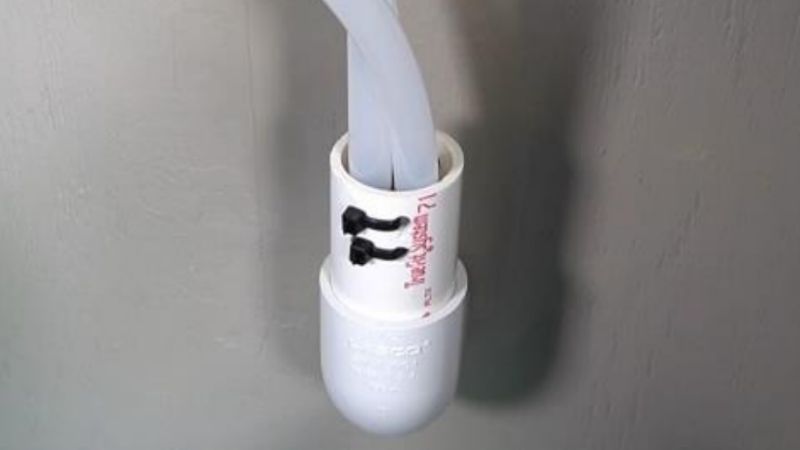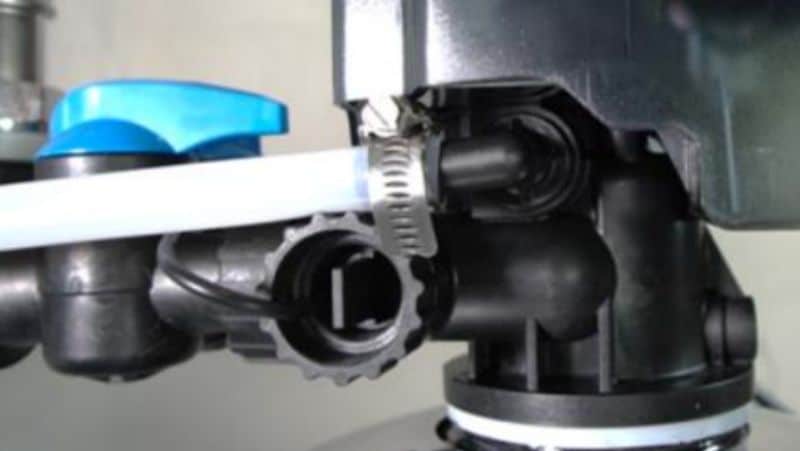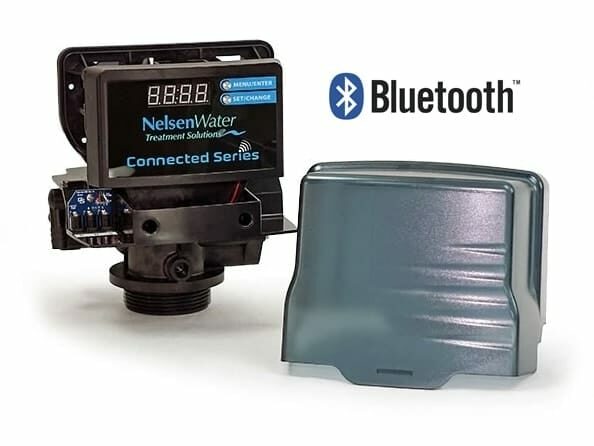Traditional water softeners add a small amount of sodium to water during the softening process. This sodium is needed to replace calcium and magnesium hardness minerals in the ion exchange process. But you shouldn’t be able to taste the salt in your water.
If your water has 18 gpg (grains per gallon) of hardness, a water softener will add about 35 mg of sodium to a standard 8-ounce glass of water. To put this into perspective, a slice of bread contains between 100 and 230 mg of sodium. So if your softener water tastes salty, there’s something wrong.
Drinking salty water isn’t pleasant, and you’ll want to solve the problem as soon as you can. In this guide, I will look at the possible causes of salty softened water, and how to fix them.
💡 What Causes Salty Water After Regeneration?
It’s a myth that water softeners make your water taste salty. Most likely, if you can taste salt, there’s something not right with the system. Below are some of the common issues that may cause salty water after regeneration.
Before diagnosing the issue, make sure your environment is safe to work in. Disconnect your water softener from its power supply and divert water away from the system using the bypass valve.
Clogged Injector
The first thing to check is your injector valve. The injector has several horizontal and vertical holes that can easily become blocked with salt, dirt and sediment.
The injector valve is a delicate part, so take care when you’re clearing the holes. Use a wooden toothpick or a toothbrush, and avoid metal objects that could make the holes bigger. If you’re struggling to free the blockage, you should buy a new valve altogether.
Drain Line Flow Control Clogged
Second, check the drain line flow control. This button is located inside the system’s elbow, and it can easily become blocked with sediment and salt. Remove and clean if necessary.
Again, it’s important to be careful when cleaning out your drain line. If it looks to be worn or damaged, it might be easier to replace the part.
Drain Line is Clogged or Crimped
If you’re still dealing with a salty water taste, look at the drain line in your hard water softener.
This line can become crimped or kinked, preventing water from being able to properly pass through. It may also be clogged with debris.
Use your hand to follow the drain line from its exit from the system’s tank, feeling for kinks and crimps along the way. Press to check for blockages that could prevent a proper flow of water.
Another issue to look for is a drain line that’s too long. If your drain line spans more than 8 feet length-ways, or there’s more than 20 feet of line between the tank and the drain, it may struggle to properly drain your unit.

Brine Line Clogged or Crimped
Your brine line may become clogged with sodium and sediment from your brine solution.
The brine line could also be crimped, preventing the brine solution from properly passing through. If water flow is uneven, there could be a build-up in the system, which might cause your water to taste salty.
Follow the steps above to check for kinks and clogs. The solution may be as simple as removing the component and cleaning it out. You might have to buy a new part if you notice any major damage.

Bad Brine Valve
The components in the brine valve, including the brine and downflow pistons and the spacer stack, may become faulty.
When this happens, brine solution might be able to leak into the resin container, where it could end up saturating the resin beads with more salt than necessary.
Remove the drain and brine elbow from your system and examine it for dripping or running water in the valve. If you spot any, you’re probably dealing with a piston or spacer stack issue. Replace the faulty parts to solve the problem.
Excessive Water in the Brine Tank
If your hard water softener malfunctions, your brine tank may overflow with water.
This can happen for a number of reasons, including clogged brine and drain lines, and salt mushing at the bottom of the tank.
Check your brine tank. There should be about 6 inches of water in there; 10 inches maximum. If there’s too much water, this could result in excessive salt absorption.
You can empty the water with a bucket or container, or a wet vac, if you have one. You’ll need to clear any blockages or reset your system if necessary to prevent the problem from recurring.
Improper Programming of Control Head
Once you’ve installed your hard water softener, your most important task is to input the right settings into the control head.
You need to correctly input your water hardness to allow the system to perform regeneration cycles according to this information.
Mechanical programming can also be affected by power outages. Whether meddling children or a lack of electricity is to blame, this might cause a change to your pre-programmed settings changing, resulting in too much salt in your water.

Brine Cycle Interrupted
During regeneration, a water softener washes calcium and magnesium minerals out of the resin bed using a brine solution. Brining usually takes between 30 and 100 minutes.
If this cycle is interrupted, you may end up drinking water with a much higher-than-average quantity of sodium ions.
Water Being Used During Regeneration
Your water softener will usually be set to perform regeneration when the unit is least likely to be used – around 2 or 3 AM.
If the timer is set to perform system regeneration during the day, rather than at its usual time, you may end up drinking salty water.
You may also wake up in the night and use your water, whether to pour yourself a glass of water or to use the toilet.
If you do this while your water softener is regenerating, it’s likely that salty water will enter your home’s pipes. The next morning, the water in your pipes will come out of your faucets.
This is easy enough to resolve. Just open your faucet and leave it to run for a couple of minutes, until your water is back to its normal taste.
Low Water Pressure
If your water pressure is lower than 30 PSI, it might not be fast-flowing enough to properly get through your softener.
Most water softeners work best with a water pressure of around 45-70 PSI. Anything lower than this may affect soft water production.
You can use a pressure gauge to read your water pressure if you’re unsure. You may want to buy a booster pump to send water through your pipes at a faster rate.
Incoming Water Has High Sodium Content
Rarely, the problem might not be with your water softener itself, but with the drinking water that enters your home.
If your water supply contains a high level of sodium already, your water softener will only add to this. It’s worth testing your drinking water for sodium ions before it reaches your water softener.
Related:
❔ Frequently Asked Questions
How much sodium should my water contain?
The exact amount of sodium needed to soften your water depends on your hardness. The harder the water, the more magnesium and calcium minerals it’ll contain – and the more sodium ions will be needed to replace them.
You can work out how much sodium will be added to your water once you know your hardness level in GPG. Then use this calculation:
Water hardness x sodium added per gallon / 16 (cups in a gallon) = amount of sodium in one 8-ounce glass.
For example, if you had a water hardness of 11 GPG and you added 30 mg of sodium per gallon, the calculation would look like this:
11 x 30/ 16 = 20.6 mg sodium/ cup
Related: The Truth About Water Softeners
How can I reduce sodium consumption?
This guide should have answered the question: “Why does my water taste salty?” But perhaps you’d rather not drink even trace amounts of sodium in your water. You might also have a medical condition that requires you to restrict your sodium intake where possible.
In this case, you’d benefit from adding potassium chloride to your hard water softener instead of sodium. Potassium chloride is almost entirely salt-free.
An alternative is to filter your softened water to remove excess sodium before you drink it. Utilizing a reverse osmosis system is the best way to achieve this. As an added bonus, the filter will remove additional contaminants like chlorine and lead.
A final option is to use a reverse osmosis unit as the final point of use for drinking water after the softener. Depending on your hardness you could opt to use a reverse osmosis instead of a softener as well. Reverse osmosis systems are typically just as effective as water softeners at removing calcium and magnesium. However, if you have particularly hard water, reverse osmosis may not be suitable, as the high mineral content could damage the RO membrane.

The ice cubes & water taste salty even though the water is filtered through a filter system on the refrigerator.
I need to know how to correct this issue as I am on a low sodium, low salt diet due to congestive heart failure.
Hey Deborah, thanks for the question. Your refrigerator water filter is unable to reduce the sodium added to the water by the softener. The most viable option to reduce sodium from softened water is with a reverse osmosis system.